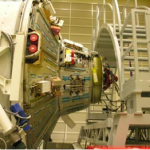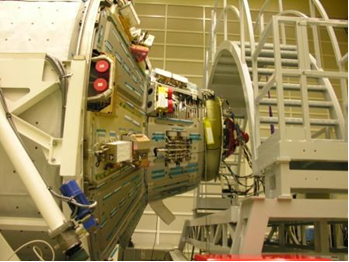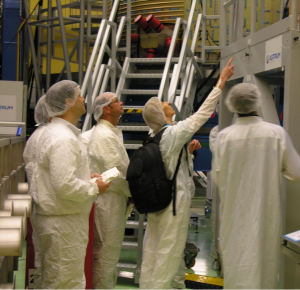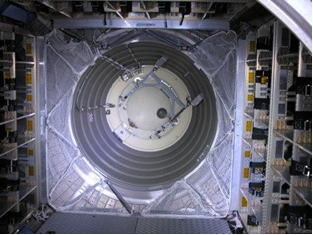After the successful completion of the ATV-2 mission on 21 June (followed by some well-earned vacation), ESA’s ATV project team are again hard at work getting ready for the Agency’s next mission to the ISS: ATV-3. ESA’s Deputy ATV Programme Head, Charlotte Beskow, has sent in a new instalment in her ongoing – and very informative – ATV Mission Diary – Eds.
Count-down clock: ATV-2 reentry +2 months, ATV-3 launch -6 months – Here we go again!
I hope you have had a pleasant and relaxing summer! Here follows an update on what has been going on in my area.
Did the end of the Shuttle spell the end of the ISS? Nope :-)! During the summer many people have asked me what we plan to do now that the space program is ‘coming to an end.’
I have explained that the end of the Shuttle is not the ‘end of the space program’ – not for NASA and certainly not for us! Yes, ISS construction is finished and we no longer ‘need’ the Shuttle to keep it running.
Crews can go up and down on Soyuz (just like they have been doing all the time) and supplies and experiments can go up with Progress, ATV and Japan’s HTV [Note: Charlotte wrote this diary update prior to last week’s Progress failure and we’re still waiting to see how this affects astronaut flights – Ed.].
So, as far as the ISS is concerned, we are definitely (staying) open for business. It’s interesting to note that, from a science standpoint, the fewer vehicles that visit the ISS the better – since the objective is to perform experiments in microgravity and all the incoming and outgoing traffic disturbs this environment.
What has changed is that we no longer have the possibility to bring up large items (i.e. bigger than the size of the Russian or US hatch) but the ISS is chock-a-block full of supplies and spares and so should be OK for many years to come. The other thing is that we have limited capability to bring experiments and equipment down intact. This is not mandatory for the running of the ISS, but we would all welcome the capability if we had it. Perhaps this can be accommodated in the future via some ‘delta’ developments on existing equipment?
The daily reports that we see coming from the mission management team are full of info regarding the experiments performed onboard. Some are really interesting even for we non-scientists and I’ll try to describe them in a later update.
ATV-3 work
In early July, we held the Crew Equipment Interface Check (CEIC). This is when we check that all crew interfaces are in line with procedures. This includes labelling, access, tools, etc. With a vehicle as complex as ATV, there is always something missing or something that can be improved and this time was no exception. However, the exercise went very smoothly and there were no disagreements on the what remains to be done – all of which can be done in Kourou without risk.
There are about 2,000 people across Europe who work on the ATV – but only a few ever get to see the vehicle. It is a nice experience to physically be present with the vehicle, even if we have to dress with care so as not to contaminate it more than necessary.
At end-July, we held the Pre-Shipment Review. This is where we go through all the testing reports to see if the vehicle is ready to be shipped. We do not want to ship if there is a risk that we need to exchange any components, since delays might impact the launch date. Also, once we are in Kourou we take up a lot of space, preventing other ‘passengers’ from using the Arianespace facilities.
It was noticeable that we had done this before (twice – ATV-1 and -2 – to be exact). The atmosphere was relaxed and constructive. Many discussions focused on shipping and logistics; one of the major topics was the need to get into Kourou harbour at the right time (tricky due to the tides) and planning the work schedule to fit within daylight hours, labour laws and equipment constraints (for example, we need to move quickly between the ship that carries ATV from Bremerhaven in Germany and the air-conditioned facilities inside CSG).
One hurdle – which did not depend on us – was Ariane flight V203. When it successfully departed on 6 August, our teams were able to access the offices and clean-room areas we need for our campaign. Everything needed to be set up before ATV arrived.
Kourou campaign
The first teams arrived on 11 August and started preparing for the rest of us. CSG gives us empty rooms, which each team member fills with whatever s/he needs. The binders full of printed documents of earlier days are gone: now we need computer displays, docking stations, wireless connections, Internet access, network printers, etc.
But – as in the past – we still need coffee machines and a refrigerator (necessary components of any launch campaign!). The fridge, by the way, is used for many things and not only food and drink. When we get close to the end of the campaign here at Kourou, the cleanliness specialists turn up and start their sampling activities. The samples are analysed by the Institute Pasteur in Cayenne and various samples are also stored in the fridge.
ATV-3 Edoardo Amaldi – “Eddie” – left Bremen harbour on 12 August. It has been on the boat across the Atlantic and as I write [24 August] it has arrived at Devil’s Island outside Kourou and is now waiting for favourable tide.
Tomorrow afternoon [25 August] the teams will start unloading the boat. The clock has already started ticking and launch date is set for 7 March 2012 [We’ve updated the count-down clock in the blog – Eds.].
Our launch campaign is scripted in great detail and takes 180 working days. This is long compared to standard telecom satellites, which accomplish their launch campaigns in 5-6 weeks.
ATV-2 carried as much fuel as possible to the ISS (over 4000 kg). Since it’s a very versatile vehicle, we will load ATV-3 to suit the needs of the ISS. Eddie will therefore carry 2200 kg of propellant, plus 860 kg of cargo for the Russian segment. We will also carry 285 kg of Russian water (the ISS uses either Russian or American water) and about 2 tonnes of dry cargo.
More news will follow.
Cheers from me
– Charlotte





 Automated Transfer Vehicle page
Automated Transfer Vehicle page ATV blog archive
ATV blog archive
Discussion: 2 comments
Thank you for the updates.
It always nice to hear from the people inside the missions rather than from news reports.
*waves hi Charlotte*
Greetings from the the OTHER ESA team in kourou (Galileo)